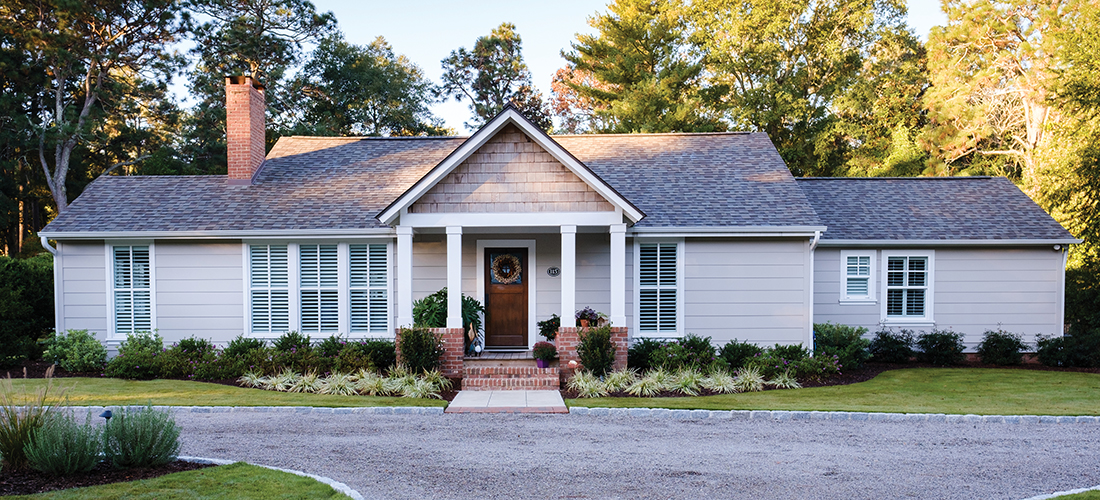
Reconstructing a Pinehurst landscape
By Claudia Watson • Photographs by Laura Gingerich
A little cottage on a well-kept street in old town Pinehurst sparked my curiosity for nearly two decades. The modest, single-story house hid behind a towering barricade of overgrown hollies. It looked melancholy except for a single camellia that hugged the tiny porch and bloomed during the dullest days of winter.
The house was built in 1957 of clapboard beveled heart pine siding and painted a then-trendy minty green. On occasion, an older woman cautiously peeked out a barely opened door, looking distraught by it all.
Nearly six years ago, after the owner died, there was an estate sale, mostly glassware, kitchen items and furnishings. A shed, almost fallen with age, was strewn with rusty yard tools and broken pots. All of it seemed so sad.
I was not the only one who was captivated by the old house. Sean Butler stopped by often to check on the owner and offered help with repairs.
“In its day, I knew it was a very nice home. It had good bones,” recalls Butler, owner of Butler Constructs. He and his business partner, Wes Smith, who lived in the neighborhood, walked through the house the day of the estate sale and made an offer on it that day. They purchased the half-acre property in 2015.
Butler’s redesign of the house maintains the original structure’s required exterior “cottagey” style. Inside, he let his imagination work as he drafted a new plan for the home, nearly doubling its size.
As work on the house continued, Angie Averitte and Patti Rainwater, both highly focused on buying a cottage in old town, noticed the renovation.
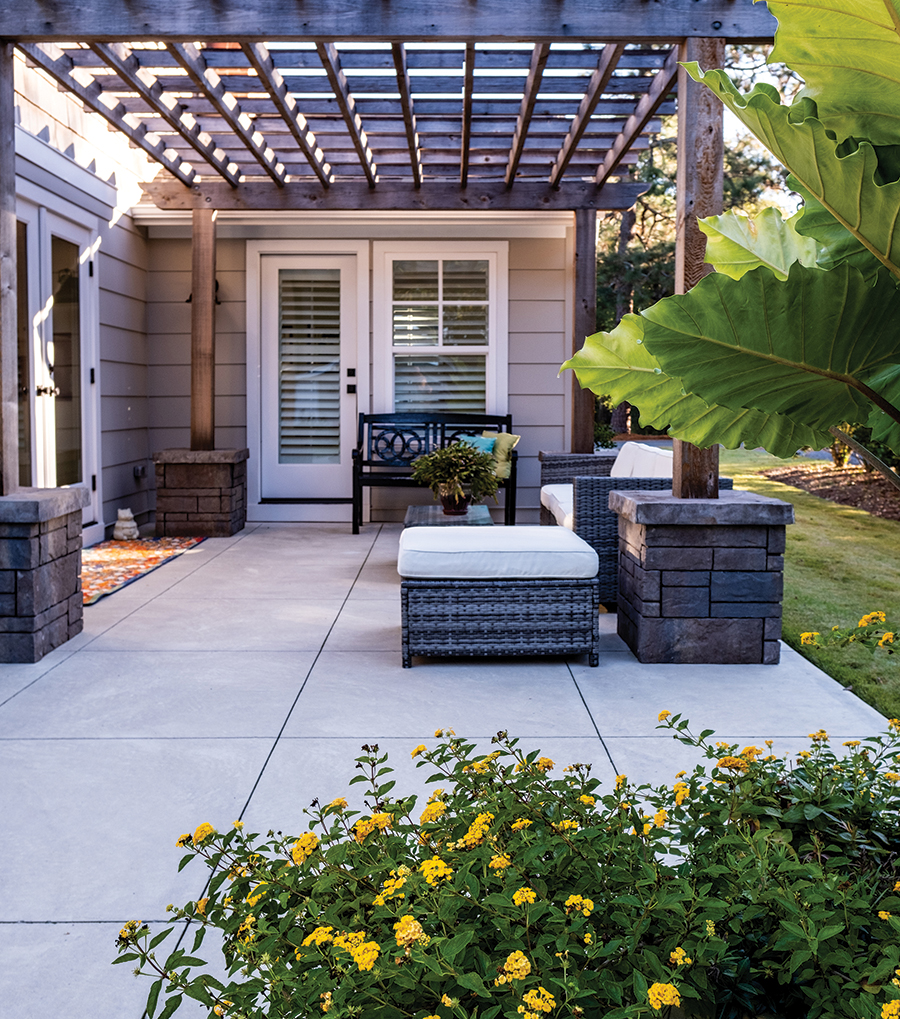
“We were in town with our real estate agent, stopped and saw that it was going on the market the next day. It was meant to be,” smiles Averitte after explaining they’d lost out on two other houses in the bidding wars of a hot real estate market.
Born down the road in Hamlet, North Carolina, Averitte started working for the predecessor of CSX Railroad in the small town. Her management career required relocating all over the East. “We called ourselves gypsies because we moved 12 times in 25 years,” she says.
When she closed her career with CSX after 38 years, she and Rainwater, a project manager for a home health company, lived in Nashville. Averitte’s desire to be with family coaxed them back to the Sandhills. “We moved back Christmas week of 2018. It was a good way to get out of Christmas,” she laughs.
Once settled, they recognized that living in a smaller house would take some adjustment. While they had many “what-if” dreams — they weren’t particularly conscious that the landscape might play a role in helping them put down strong roots.
During the late winter months, they’d walk the property assessing its potential. “We had a new patio, an old shed, some dead shrubs and a bit of a drainage issue, and didn’t know where to begin,” says Averitte. “We wanted livable outdoor space that was pretty, offered privacy and a place for entertaining. It was obvious that we needed help.”
At the suggestion of a friend, she called and then hired Dee Johnson, a highly recognized landscape designer who has always had a deep passion for gardens and horticulture. Growing up in rural West Virginia, Johnson often worked alongside her grandmother, an avid gardener. She and her parents enjoyed the outdoors, and getting their hands dirty was part of each day. She studied botany in college and relocated before receiving an undergraduate degree. When she and her husband moved to the Sandhills, she explored the Landscape Gardening program at Sandhills Community College.
“I thought it would be a nice hobby,” she laughs. She earned an associate degree in landscape gardening and began teaching in the Continuing Education program. After receiving an undergraduate degree in education and a master’s degree in agricultural extension education, she returned to teaching. Appointed coordinator of the landscape gardening program at SCC, she held the post 17 years. Her private design business remained in the background, but she geared it back up once she retired.
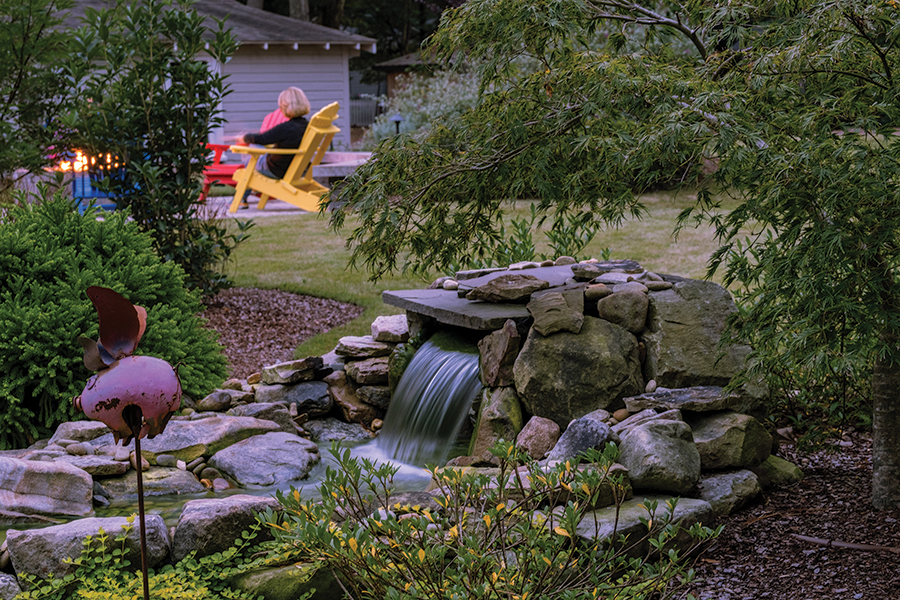
Johnson describes her design style as naturalistic — and she does not mean native plants, but plants in their natural form. Though she does design formal Williamsburg-type landscapes, these are not her preference. She disdains power shears used to make meatballs of shrubs.
“Plants will fight you tooth and nail. If it’s not supposed to be round, don’t make it. It’s going to try to go back to its natural state,” she insists.
One of Johnson’s formative influences is British landscape designer John Brookes, who introduced the notion that “gardens should be low-maintenance as well as beautiful by recognizing the proposed use of a garden before designing it.” He felt this ensured “that lifestyle, architecture and garden are a harmonious whole.”
Johnson uses the same approach with clients, and emphasizes they need to consider how they want the space to function. Those characteristics and the site orientation, house style, outbuildings and cultural history drive her gardens’ design and style.
These aspects are equally important as the practical considerations of budget and how much time the owner has to maintain the area. Being prepared with the information upfront keeps the plan and planting scheme on track and tailored toward the client’s taste.
Even if it’s a DIY landscape renovation, going in without a plan is not a good strategy. “It’s like going to the grocery store without your list. You’ll end up spending money on things you don’t need, then trying to find a place for it all, and then digging yourself out with a shovel for a long time,” Johnson says.
After a thorough site assessment, Johnson presented her proposal, including landscape and hardscape details, budget and timeframe. Though not a requirement of Johnson’s, Averitte and Rainwater elected to have her bid out the project and supervise the installation to ensure its successful completion.
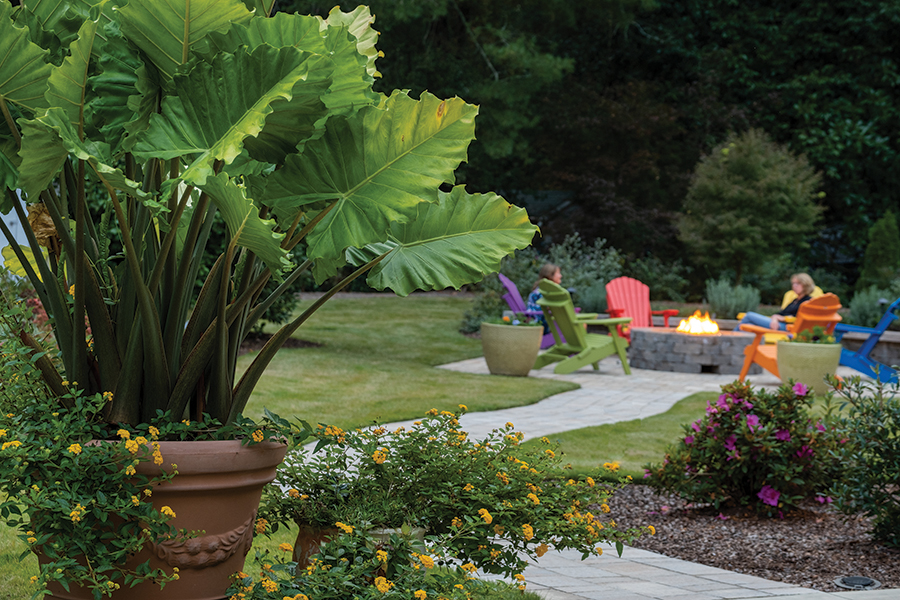
Johnson promised a turnkey project. She used Joe Granato of Star Ridge Aquatics and Richie Cole of Knats Creek Nursery, two contractors who know her work and expectations. Start to finish, the project was completed in eight weeks, and just in time to take full advantage of the autumn rain and cooler temperatures that gave plants their roots.
The design is balanced and merges beautifully with the surroundings. It sets the space for arrival, and an invitation to explore and participate in the landscape. There are distinct areas of the landscape, with some “rooms” open and spacious, and others cozy and intimate. All of it is colorful year-round.
At the front entry, a whimsical masked tin pig peeks out from under the giant leaves of a potted philodendron Philodendron selloum that Averitt has toted around for 30 years. Another keepsake, a toxic Jerusalem cherry evergreen shrub Solanum pseudocapsicum, steals the show with boldly red, yellow, and orange fruit.
The owners, not fans of crape myrtles, asked that the two crape myrtles next to the house be removed. Johnson creatively moved them forward to a new planting bed between the semi-circular driveway entrances.
“This is a basic design principle,” explains Johnson. “You want to soften the edges of the house and the roof ridgeline and move your eye toward the front door.”
The crape myrtles give height to the area, as dwarf buddleia, fountain grass, rosemary, variegated liriope and yucca offer a tidy look and color throughout the year.
As with many old town cottages, the practical but pesky issue is the lack of a garage. For the owners, who have two cars, maneuvering to park in the semi-circular driveway was tricky.
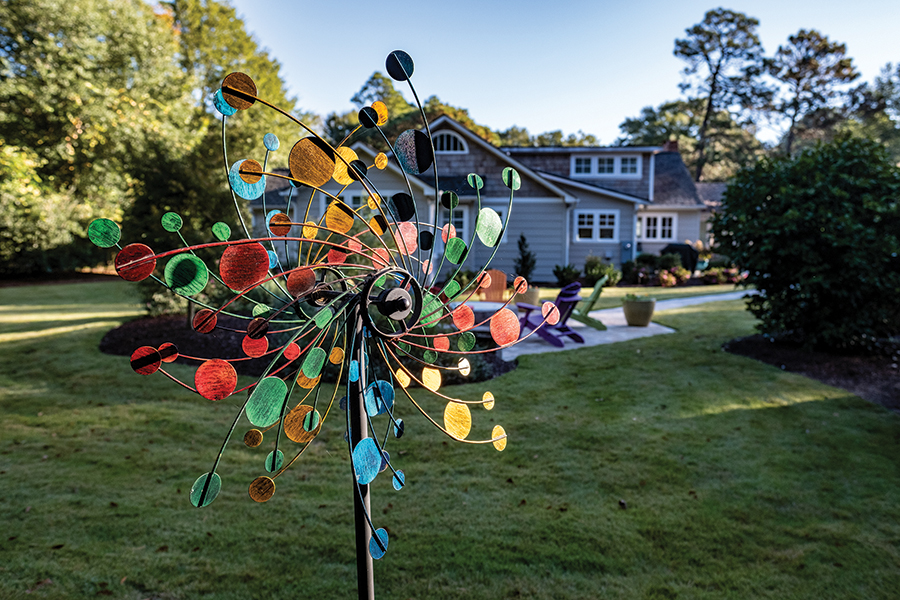
“Every time I was there, someone had to move a car,” recalls Johnson. She widened the driveway to permit another car to move by a parked car and added a parking area to the side. Now, tumbled stone edging keeps driveway gravel out of the grass and provides a finished edge that blends in with the surrounding plantings.
Johnson carefully plants closer to the property’s edge, which helps define the barefoot-friendly Zeon zoysia lawn. The garden areas serve as visual boundaries to the property, creating a pleasing view from inside the house by giving the eye more to see than just grass.
The small, one-story house suggests the plantings’ scale and shape, and a linear planting design combined with curved beds keep the eye moving across the site. The use of plants with shorter growth habits allows the owners to enjoy the view from their windows without much maintenance.
From the street, a passerby catches a glimpse of the colorful perennial and herb garden. It’s tucked into the back corner of the property and bordered by a cedar privacy fence. The old shed was renovated to become the she shed, its lines softened by blueberry bushes at the entrance and the young hardy kiwi vines Actinidia arguta ambling skyward along a sturdy cedar arbor.
Anchored by a delicate ‘Forest pansy’ redbud Cercsis canadensis, several Camellia sasanqua ‘Survivor,’ and a trio of winter hardy Hydrangea paniculata ‘Limelight,’ the garden provides breathtaking summer and late autumn color.
In the spring, the Itea virginica ‘Little Henry’ blooms in a cascade of lightly fragrant white spikes. Its foliage deepens to orange and red colors into autumn. Existing loropetalum, boxwoods, and miscanthus grasses were relocated to the area to extend the allure during the winter months.
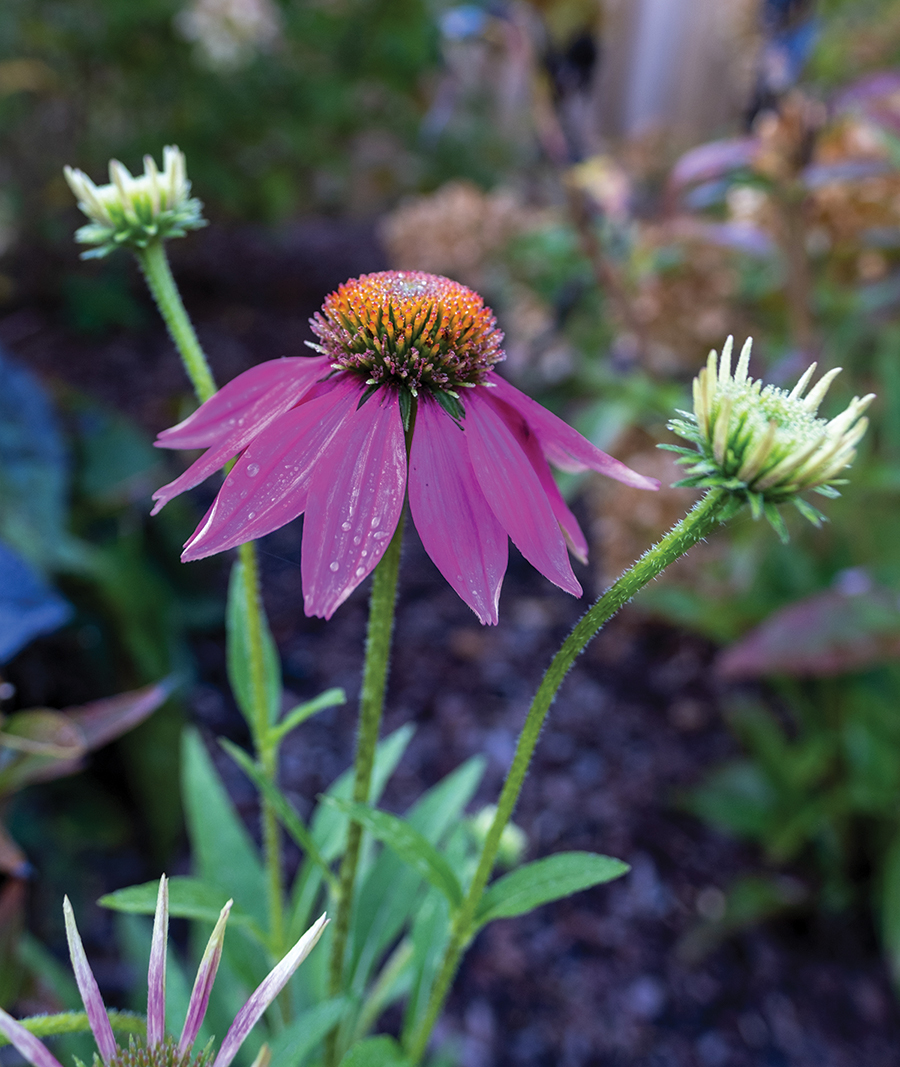
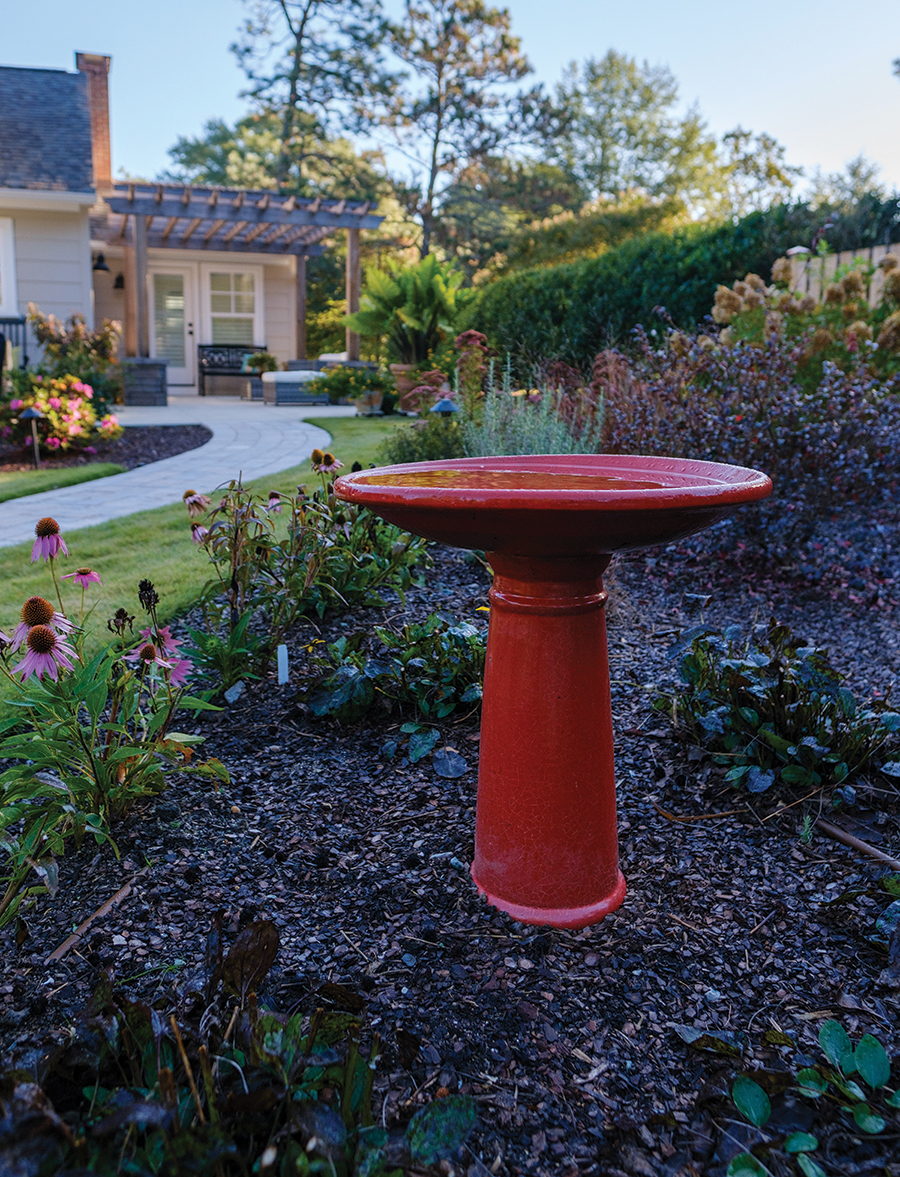
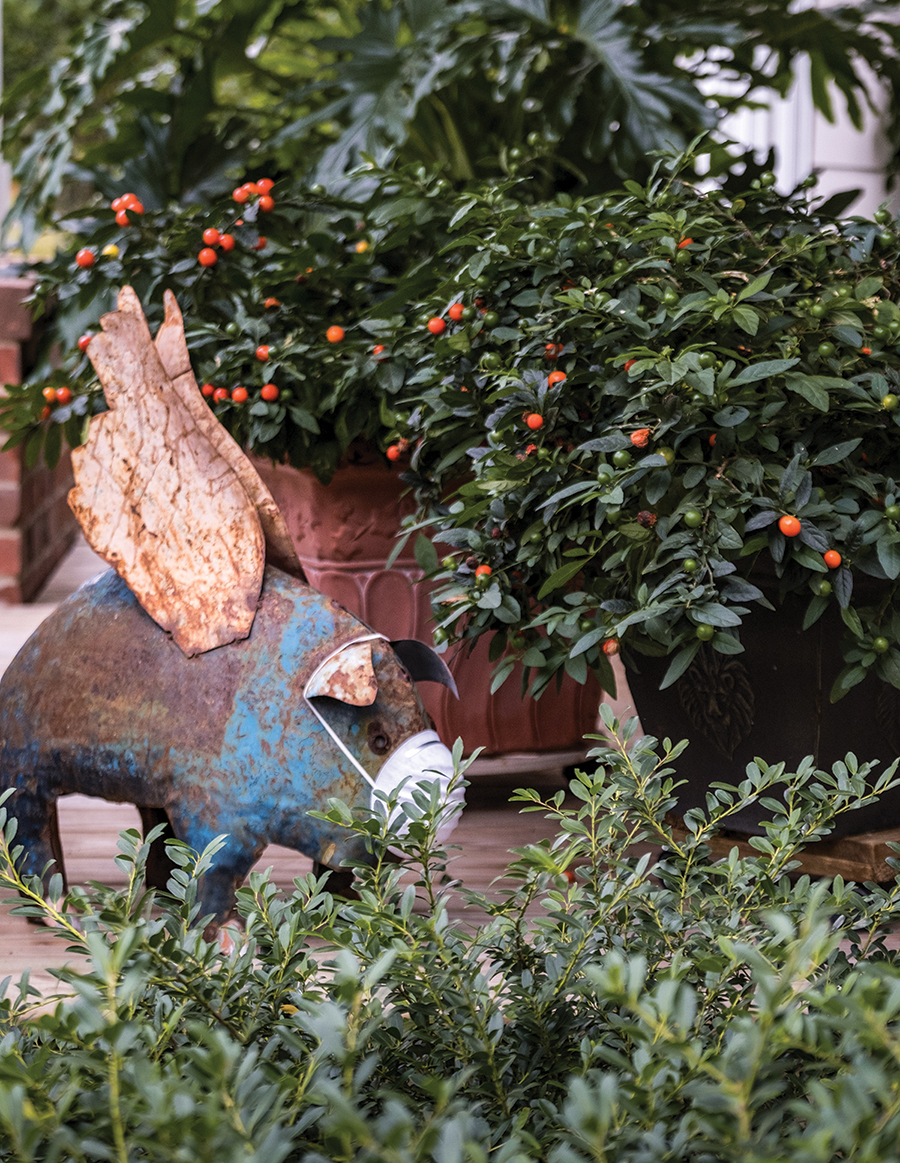
But it’s the perennials that provide the punch. The flower combinations complement each other rather than clash or compete.
Pollinator favorites like Coreopsis Coreopsis lanceolate ‘Moonbeam,’ Walker’s Low catmint Nepeta x faassenii ‘Walker’s Low,’ Coneflower Echinacea purpurea, Goldstrum black-eyed Susan Rudbeckia fulgida, Black and Blue Salvia Salvia guaranitica, and the dependable Stonecrop, Sedum ‘Autumn Joy’ enliven the garden.
Johnson blends eucalyptus, lamb’s ear, rosemary, culinary sage and English lavender into the garden with an appreciation for the texture and fragrance offered by silvery foliage.
Just out the kitchen door is the often-used pergola-covered patio. It’s become a favorite spot for a glass of wine before dinner, especially when the nearby cluster of gardenia Gardenia jasminoides ‘Kleim’s Hardy’ releases its heavenly scent.
But of all the new spaces, it’s the striking fire pit that draws the accolades. A curved stone walkway leads to the area that seats six in rainbow-colored Adirondack chairs conveniently outfitted with cup and wineglass holders.
“It was insightful, though we didn’t know it at the time,” Averitte remembers. “When COVID started, we didn’t interact with anyone for two to three months. Once spring came, and the yard was full of blooms, we invited two friends over and a couple of neighbors. It morphed into a pretty cool and safe way to visit in the middle of this pandemic.”
A sitting ledge hugs the back curve with the surrounding garden filled with Verbena ‘Homestead purple’, English lavender and butterfly bush Buddleja davidii ‘White Provision.’ A laceleaf Japanese maple Acer palmatum ‘Seiryu’ is flanked by two lovely hydrangea Hydrangea quercifloia ‘Snowflake,’ providing visual height, privacy and spectacular seasonal color — at least until the deer discovered them — calling for new options.
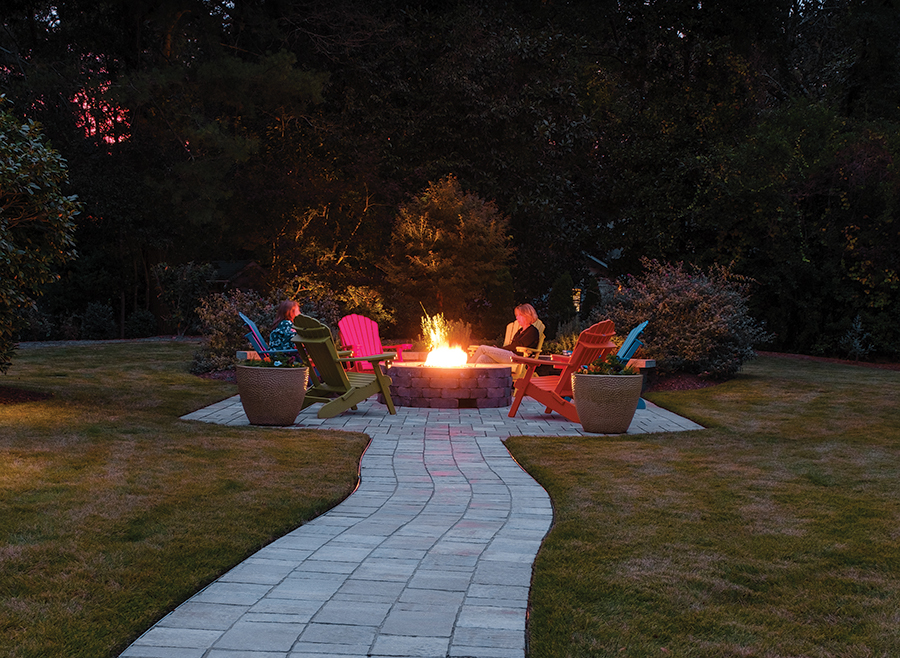
As the moon rises in a velvety blue sky, the intimate water garden off the master suite is a tranquil setting with the sound of falling water accompanied by a chorus of frog calls. The backlit Japanese maple Acer palmatum ‘Waterfall’ and saucer magnolia Magnolia soulangeana ‘Jane’ offer a pretty backdrop. Dwarf gardenias Gardenia jasminoides ‘Radicans’ provide fragrance, and Sweet flag Acorus gramineus ‘Ogon’ adds spiky texture and bright color.
Averitte says she was impressed by Johnson’s attention to detail and dedication to the project. “Her work touched every part of our property and, in so many ways, and that’s enhanced our lives.”
Living in a smaller house has been a significant change. Still, she and Rainwater agree that they have a greater appreciation for nature’s calming power, especially during the pandemic.
“It’s become our sanctuary,” says Averitte quietly, who never considered herself a gardener. “I find myself in the garden and bringing the garden inside now — taking snippets, spending time deadheading plants, and thinking about how this beautiful place is all ours now. We’ve put down our roots and will be here for a long time.”
As for the little cottage, it’s renewed and happy again, too. PS
Claudia Watson is a frequent contributor to PineStraw and The Pilot and finds the joy in each day, often in a garden.





